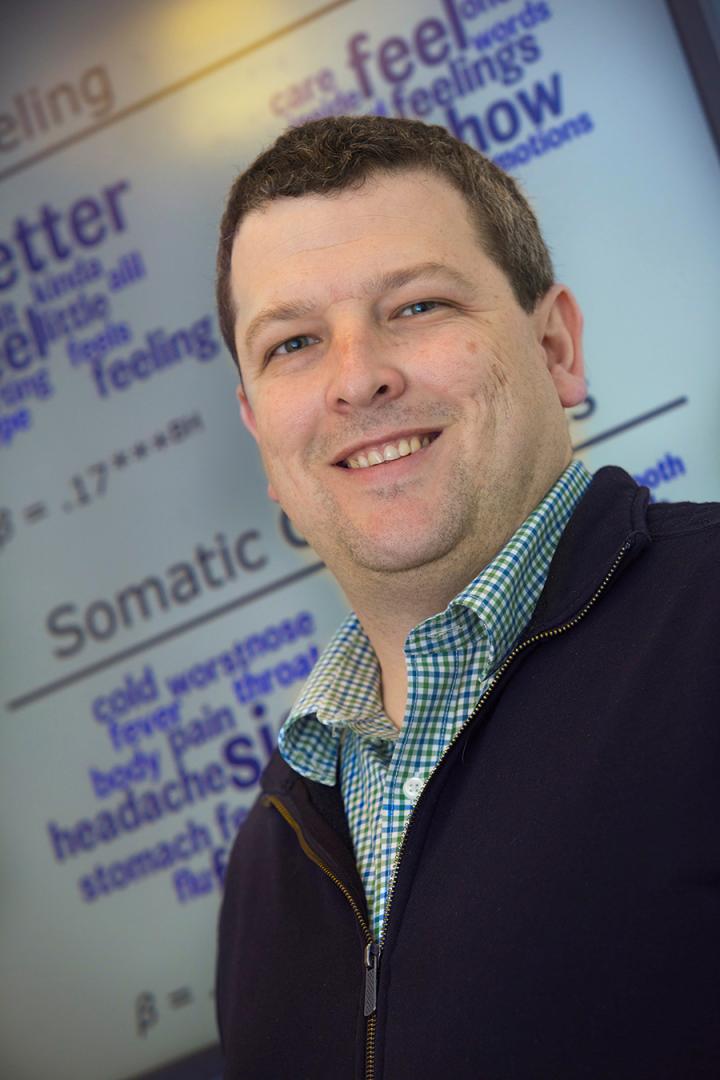Analysis shows that language in posts becomes less formal and invokes family more often

Credit: Stony Brook University
STONY BROOK, NY, March 12, 2020 – A new study published in Scientific Reports reveals that the language people use on Facebook subtly changes before they make a visit to the emergency department (ED). A team of researchers in part led by H. Andrew Schwartz, PhD, Assistant Professor of Computer Science at Stony Brook University along with Sharath Chandra Guntuku, PhD, a research scientist in Penn Medicine’s Center for Digital Health, compared patients’ Facebook posts to their medical records, which showed that a shift to more formal language and/or descriptions of physical pain, among other changes, reliably preceded hospital visits. The study provides more evidence that social media is often an unseen signal of medical distress and could be used to better understand the contexts in which patients seek care, such as during the current COVID-19 pandemic.
The study’s researchers recruited 2,915 patients at an urban hospital who consented to sharing their Facebook posts and electronic health records (EHRs). Of those patients, 419 had a recent emergency department (ED) visit, ranging from chest pain to pregnancy-related issues. Posts from as early as two-and-a-half months before the date of the patients’ ED visit were analyzed using a machine learning model that processed their language to find changes over time.
As patients got closer to their eventual ED visit, the researchers found that Facebook posts increasingly discussed family and health more. They also used more anxious, worrisome, and depressed language and less informal language such as “lol” “?” or swearing.
“The decrease in informal language seems to go hand-in-hand with an increase in anxiety-related language,” said Schwartz, who collaborated with the Penn Medicine Center for Digital Health, part of the Perelman School of Medicine at the University of Pennsylvania. “While it is hard to say right now if this would be the same result across multiple social media platforms, people live a lot of their lives online and Facebook is that dominant platform right now.”
“The better we understand the context in which people are seeking care, the better they can be attended to,” said lead author Guntuku. “While this research is in a very early stage, it could potentially be used to both identify at-risk patients for immediate follow-up or facilitate more proactive messaging for patients reporting doubts about what to do before a specific procedure.” Guntuku and Schwartz designed and conducted the analyses along with Stony Brook University graduate student, Adarsh Kashyap, MS CS.
Ultimately, it was found that most patients underwent a significant change in language before they went to the ED. Before their visit, patients were less likely to post about leisure (not using words like “play,” “fun,” and “nap”) or use internet slang and informal language (such as using “u” instead of “you”).
When the researchers looked more closely at the context of some posts, they noticed there might be some clues to patients’ health behaviors related directly to their hospital visit. One post, for example, talked about the patient eating a cheeseburger and fries less than a month before they were admitted for chest pain related to having heart failure. Another patient confirmed that they were following directions from their care team, posting about fasting 24 hours before they had a scheduled surgery.
“How does life affect personal decisions to seek care? How does care affect life? These are the things I would hope that we could fully describe, how people’s everyday lives intermix with health care,” Schwartz added.
The study primarily looked at the change in language before a hospital visit, but a previous study involving Schwartz and the paper’s senior author, Raina Merchant, MD, the director of the Center for Digital Health, showed that a person’s depression could be predicted through the language of Facebook posts as far ahead as three months before official diagnosis.
Guntuku said that there is tremendous potential in user generated content (on Facebook, Twitter, and now on smartphones) to study the behaviors and mental states that lead to a healthcare visit. “Any research in this domain must give patient privacy and agency utmost priority and transparency about where, how and by whom these digital markers are being used to understand health is critical,” he added.
The researchers plan to study broader populations in subsequent studies in an attempt to understand what actionable and interpretable insights can be provided to patients who opted to share their data.
###
Media Contact
Greg Filiano
[email protected]
631-444-9343




